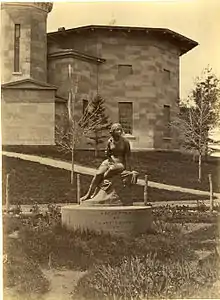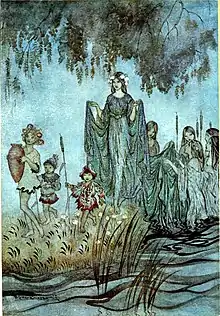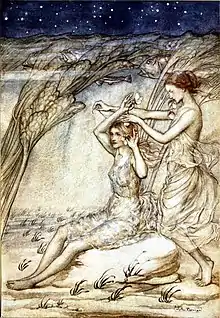Hafren
Hafren (or Sabre, Sabren, or Sabrina; Welsh: Hafren; Old Welsh: Habren) is a legendary British princess who was drowned in the River Severn by her repudiated stepmother Gwendolen. The legend appears in Geoffrey of Monmouth's pseudohistorical chronicle Historia Regum Britanniae (c. 1136). According to Geoffrey, Hafren is the eponym of the Severn, which bears one of Britain's most ancient river names (recorded as early as the 2nd century in the Latinized form Sabrina).[1]

Historia Regum Britanniae

In Geoffrey of Monmouth's Historia Regum Britanniae (c. 1138), Hafren (who Geoffrey calls Sabre) was the beautiful daughter of King Locrin of the Britons by his secret lover, a Germanic princess named Estrildis. Her mother had been abducted by Humber the Hun and brought to Britain during their invasion following King Brutus' death; eventually the Hun invasion was suppressed by Locrin, Brutus' eldest son, who fell in love with Estrildis upon discovering her in one of Humber's ships.
Locrin had been forced into a "diplomatic" marriage to Gwendolen, the daughter of King Corineus of Cornwall, but upon the death of Corineus, Locrin divorced her and made Estrildis his queen—thereby legitimizing Sabre. Locrin's scorned first wife, the mother of his heir Maddan, raised a Cornish army against him, defeated him in battle, and had his widow and daughter drowned in the River Severn:
[Gwendolen] commanded Estrildis and her daughter Sabre to be thrown into the river now called the Severn, and published an edict though all Britain, that the river should bear the damsel's name, hoping by this to perpetuate her memory, and by that the infamy of her husband. So that to this day the river is called in the British tongue Sabren, which by the corruption of the name is in another language Sabrina.[2]
Welsh tradition

A different version of the story is recorded in Oliver Mathews' Towne of Sallop (1616). In this version, Hafren's mother Estrildis is called Sŵs-wên, and Locrinus builds the town of Caersws for her around 1086 BC, where she gives birth to Hafren (called Haverwen or Havfren) out of wedlock. Locrinus marries Sŵs-wên after the death of Corineus, causing Gwendolen to raise an army and kill Locrinus. Gwendolen then travels to Caersws, razes it to the ground, kills both Sŵs-wên and Haverwen, and throws their bodies into the River Severn, which the Britons then name Haverne after Haverwen. It claims that the Romans later called them Eistride and Sabrina or Severne.[3][4][5]
According to local legends reported by the antiquarian Thomas Pennant, Hafren was drowned at Dolforwyn Castle; Dôl-forwyn literally means 'maiden's meadow' in Welsh.[6]
Richard Williams Morgan drew on the previous two stories, and expanded them in The British Kymry (1857).[7] In it, Locrinus builds a palace for Estrildis (who Morgan says was also known as Susa) at Caersws, where he concealed her for seven years with the help of his brother Camber. Hafren (called Sabra) is born, and is even more beautiful than Estrildis, rivalling her ancestor Venus (Locrinus was a descendant of Venus' son Aeneas). When Corineus dies, Gwendolen's army fights Locrinus' forces at the River Stour, and after killing him she hurries to Caersws and seizes Estrildis and Sabra. She orders Estrildis to be killed immediately, but was "so moved by the supernatural loveliness of Sabra, that many days elapsed before she could be persuaded to condemn her to death". Sabra was then taken to a meadow (Dôl-forwyn, 'the maiden's meadow') by Gwendolen's guards, and cast into the River Severn.[8]
In literature

Edmund Spenser retold the story in book two, canto ten of his poem The Faerie Queene (1590). Estrild and Sabrina flee Guendolene, who catches them at the River Severn, killing Estrild, but casting "the faire Sabrina almost dead with feare" into the river to drown.[9]
The Welsh tale of Hafren (variously referred to as Averne, Sabre, Sabren, Sabrina, etc.) was adapted by Milton for his masque Comus (1634), in which the following verses are addressed to the water nymph "Sabrina":
Sabrina fair,
Listen where thou art sitting
Under the glassy, cool, translucent wave,
In twisted braids of lilies knitting
The loose train of thy amber-dropping hair;
Listen for dear honour's sake,
Goddess of the silver lake,
Listen and save!
In art
Several statues of Sabrina were made, including by Peter Hollins (1846),[10] Holme Cardwell (1865),[11] three by William Calder Marshall (including Amherst College's Statue of Sabrina), John Graham Lough, and others.[12] In 1858 the architect and designer, William Burges, produced drawings and plans for a fountain commemorating Sabrina to be located in the city of Gloucester, but it was never constructed.[13]
See also
- Sabrina Way, a long distance footpath
- 2264 Sabrina, a minor planet named after Hafren
References
- Hanks, Patrick (2003). "Severn". Dictionary of American Family Names. Retrieved 10 December 2012.
[T]opographic name from the river Severn, which flows from Wales through much of western England to the Bristol Channel. The river name is recorded as early as the 2nd century ad in the form Sabrina. This is one of Britain's most ancient river names; the original meaning is uncertain, but it may have been 'slow-moving'.
- Giles, J. A., ed. (1848). . Geoffrey's British History. Six Old English Chronicles. Translated by Thompson, Aaron. OCLC 1834236 – via Wikisource.
- Hearne, Thomas, ed. (1722). The History and Antiquities of Glastonbury. Oxford. pp. 249–251.
- Morris, Rupert, ed. (1911). Parochialia. Archaeologia Cambrensis. Vol. 3. London: Cambrian Archaeological Association. p. 99.
- Bartrum, Peter C. (2009) [1993]. "Locrinus" (PDF). In MPS (ed.). A Welsh Classical Dictionary. Vol. 7. National Library of Wales. p. 485.
- Pennant, Thomas (1883). Rhys, John (ed.). Tours in Wales. Vol. 3. Caernarvon: H. Humphreys. pp. 175–177.
- Hamer, Edward (1868). "Ancient Arwystli". Archaeologia Cambrensis. 3. London: J. Russell Smith. 14 (53): 4.
- Morgan, R. W. (1857). The British Kymry, Or Britons of Cambria. Ruthin: I. Clarke. pp. 33–34.
- Spenser, Edmund (1590). The Faerie Queene. p. 330.
- "Statue of Sabrina in the Dingle, Shrewsbury – 1255029". Historic England. 30 May 1953. Retrieved 23 December 2022.
- "Antique 19th Century Sculpture". Jennmaur Gallery. Retrieved 23 December 2022.
- "Discover Artworks". Art UK. Retrieved 24 December 2022.
- "Sketch for a Fountain for the City of Gloucester". Victoria and Albert Museum. Retrieved 3 September 2023.
External links
- "Tales of the Riverbank: The Legend of Sabrina" from BBC Radio 3's The Essay